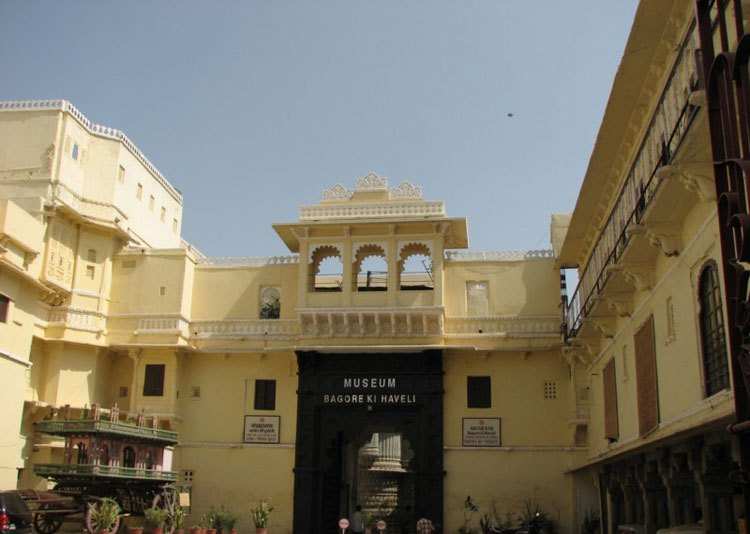A peep into Bagore Ki Haveli Museum
At Gangaur Ghat on the bank of the famous Pichola lake in Udaipur is situated ‘Bagore Ki Haveli’ which was built between 1751 and 1778 by Amarchand badwa, the prime minister of Mewar during the reign of Maharana Pratap singh II, Raj Singh II, Ari Singh and Hamir singh. The period of Badwa’s staying in the Haveli is not precisely known. After the passing away of Badwa the Haveli came under the control of Mewar state, and was given to the Maharaja of Bagore who was a close relative of the Maharana.
 At Gangaur Ghat on the bank of the famous Pichola lake in Udaipur is situated ‘Bagore Ki Haveli’ which was built between 1751 and 1778 by Amarchand badwa, the prime minister of Mewar during the reign of Maharana Pratap singh II, Raj Singh II, Ari Singh and Hamir singh. The period of Badwa’s staying in the Haveli is not precisely known. After the passing away of Badwa the Haveli came under the control of Mewar state, and was given to the Maharaja of Bagore who was a close relative of the Maharana. After Independence, the Haveli came under the control of public works dept. of the Govt. of Rajasthan and was used to accommodate Govt. servants. Many changes were made resulting in the loss of the original character of the grand building. Finally, in 1986 the building was handed over to West Zone Cultural Center which is one out of the seven in the country established by the Central Govt. for the creative development of performing art, visual arts, literary work and traditional folk and tribal arts. There is an emphasis on the revival of vanishing arts and craft forms and organization of arts and crafts fairs and festival. Rajasthan, Gujarat, Maharashtra, Goa, Daman Diu, and Dadar Nagar Haveli are the areas covered by this centre. As the Haveli had a charming style, typical of the very best Mewari architecture with a unique character of its own, it was decided to convert it into a museum. To restore it as faithfully as possible, as an example of how a Haveli would have looked and how life they would have been, an elaborate plan was chalked out. It took five years of arduous restoration work and the investment of a huge amount of money to restore the Haveli beautifully so that it depicts the royal life style, architecture and cultural ethos in its pristine glory. Local masons and artisan formed the team that took up the strenuous work. To give each room an accurate glimpse of the royal past, members of the nobility and experts were consulted. During restoration, beneath many layers of white wash were uncovered many frescoes that belonged to 18 th and 19 th
At Gangaur Ghat on the bank of the famous Pichola lake in Udaipur is situated ‘Bagore Ki Haveli’ which was built between 1751 and 1778 by Amarchand badwa, the prime minister of Mewar during the reign of Maharana Pratap singh II, Raj Singh II, Ari Singh and Hamir singh. The period of Badwa’s staying in the Haveli is not precisely known. After the passing away of Badwa the Haveli came under the control of Mewar state, and was given to the Maharaja of Bagore who was a close relative of the Maharana. After Independence, the Haveli came under the control of public works dept. of the Govt. of Rajasthan and was used to accommodate Govt. servants. Many changes were made resulting in the loss of the original character of the grand building. Finally, in 1986 the building was handed over to West Zone Cultural Center which is one out of the seven in the country established by the Central Govt. for the creative development of performing art, visual arts, literary work and traditional folk and tribal arts. There is an emphasis on the revival of vanishing arts and craft forms and organization of arts and crafts fairs and festival. Rajasthan, Gujarat, Maharashtra, Goa, Daman Diu, and Dadar Nagar Haveli are the areas covered by this centre. As the Haveli had a charming style, typical of the very best Mewari architecture with a unique character of its own, it was decided to convert it into a museum. To restore it as faithfully as possible, as an example of how a Haveli would have looked and how life they would have been, an elaborate plan was chalked out. It took five years of arduous restoration work and the investment of a huge amount of money to restore the Haveli beautifully so that it depicts the royal life style, architecture and cultural ethos in its pristine glory. Local masons and artisan formed the team that took up the strenuous work. To give each room an accurate glimpse of the royal past, members of the nobility and experts were consulted. During restoration, beneath many layers of white wash were uncovered many frescoes that belonged to 18 th and 19 thTo join us on Facebook Click Here and Subscribe to UdaipurTimes Broadcast channels on GoogleNews | Telegram | Signal


